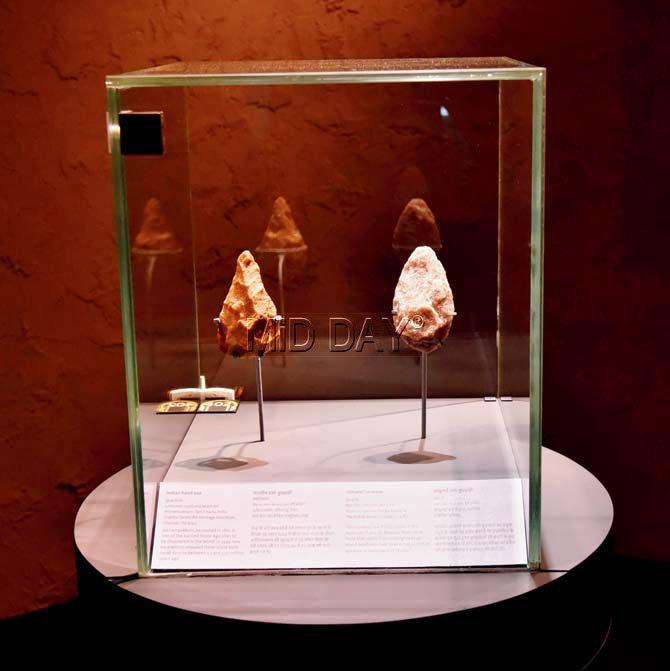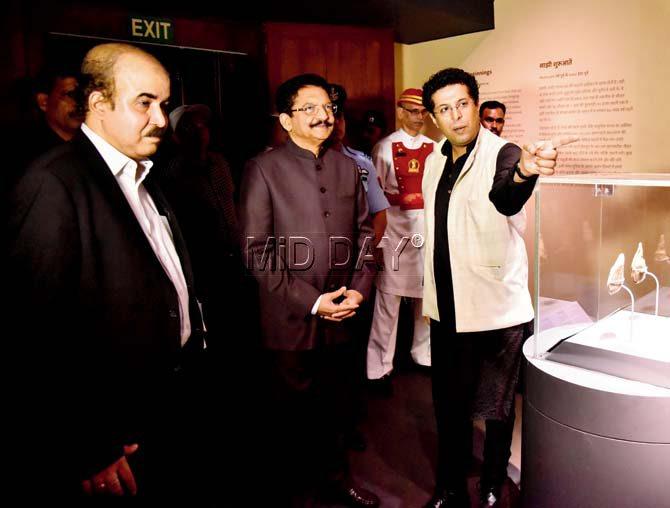Three museums unite to present an exhibition of 228 pieces that look at the connections and comparisons of India with the rest of the world

This is what Sabyasachi Mukherjee, director general, Chhatrapati Shivaji Maharaj Vastu Sangrahalaya (CSMVS) describes as the mother of all exhibitions. It took three museums and three years to curate the massive 228-piece exhibition, India and the World: A History in Nine Stories, which will be open in the city till February 2018, and then, travel to Delhi later.

The Townley Discobolus placed in the foyer. Pics/Pradeep Dhivar
ADVERTISEMENT
Conceptualised by Mukherjee and Neil MacGregor, former director of British Museum (BM), the exhibition looks at landmarks in India's history, starting from 1.7 million-year-old Stone Age tools, to the Indian Independence. The exhibition will feature a host of cultural activities, workshops and talks too.

A quartzite Indian hand axe and a Olduvai hand axe from Tanzania
Connecting links
Co-curated by JD Hill of BM and Naman Ahuja, the exhibition has taken shape as a collaboration between CSMVS, BM and National Museum, New Delhi. The core thought behind it is to present comparisons between Indian history and the world, which has been done by juxtaposing significant pieces dating to similar time zones.

Sabyasachi Mukherjee (left) with Governor C Vidyasagar Rao and co-curator Naman Ahuja
Supported by Tata Trusts and The Getty Foundation, the exhibition celebrates 70 years of Indian Independence and the UK-India Year of Culture 2017. "The exhibition, which was even discussed between former PM David Cameron and Prime Minister Narendra Modi, shows the interconnected nature of the world," said Mukherjee.
BM director Hartwig Fischer added, "The beauty is in the economy of the exhibition. These are not just objects, you will encounter people behind every object - how it was created, traded and used. These objects are not just history books stuffed in a corner [on the task of restricting the number of pieces to cover a vast timeline]."
"In many ways, the conversations here between objects show that the making of art is agnostic of boundaries, and culture is really bound to custom, food, habit and the land, and that is what gives it particularities in any given time, not nationhood that came long after many of these objects were made," said Deepika Sorabjee, head, arts and culture, Tata Trusts.
The walkthrough
The press conference was followed by the co-curators, Ahuja and Hill, conducting a walkthrough of the exhibition. The welcome foyer gives a fitting start with The Townley Discobolus, AD 100-200, BM, London, placed in the centre of the museum.
One of the biggest highlights at BM, the marble sculpture of a disc thrower, which shows the body of a youthful, ideal athlete, stands next to a statue of Hanuman, the Hindu god revered for his strength.
The nine stories covered in the exhibition are Shared Beginnings, First Cities, Empire, State and Faith, Picturing the Divine, Indian Ocean Traders, Court Cultures, Quest for Freedom and Time Unbound (which displays contemporary art). "It's fascinating to see how humans had the same answer to similar problems, in spite of living civilisations apart," Hill tells us, citing a 1.7-million-year-old quartzite Indian hand axe excavated in Tamil Nadu and a 800,000- to 400,000-year-old Olduvai hand axe from Tanzania placed next to it. Another example is a Mauryan Pillar Capital (about 320-270 BC) with rosettes commonly seen in Persian Achaemenid art and a Persian Achaemenid relief (599-400 BC) that comes from the palace of Persepolis.
Such similarities continue to reflect in all the pieces we see, and state that inter-region dialogues have been a common incidence since ancient ages. The Head of Kushan King (150 AD), of Roman emperor Hadrian (117-138 AD) and head in the style of Alexander (100-200 AD) show how political propaganda was spread by erecting busts and statues of kings throughout different ages. "Coins and other currencies in countries carry faces of national leaders. It's interesting to see that many such heads were erected by the successors of the subject of the statues, a practice that might be the reason behind the current style of using faces on our currency," Hill adds.
The similarities and connections continue to raise a head in all the mediums, be it fabrics, art or texts, hence, ably explaining the motto of the exhibition.
 Subscribe today by clicking the link and stay updated with the latest news!" Click here!
Subscribe today by clicking the link and stay updated with the latest news!" Click here!







